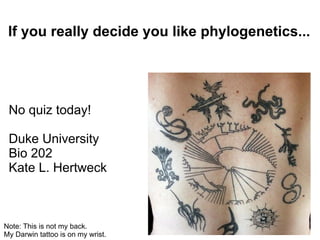
Phylolecture
- 1. If you really decide you like phylogenetics... No quiz today! Duke University Bio 202 Kate L. Hertweck Note: This is not my back. My Darwin tattoo is on my wrist.
- 2. The main idea of phylogenetics ● A phylogenetic tree (phylogeny) represents evolutionary relationships among a group – Hierarchical in nature – Group may consist of species, genes, families, etc ● How to do it: – Obtain data – Decide on homology (common evolutionary origin, multiple sequence alignment) – Build phylogeny (many kinds of software available)
- 3. Why bother? Phylogenetic evidence is vital in criminal cases of HIV transmission (Scaduto et al., 2010, PNAS)
- 4. Why bother? Your flu vaccine would be ineffective without phylogenetics (Ferguson and Anderson, 2010, Nature Medicine) How does it work?
- 5. Parts of a phylogeny ● Leaves (tips): individually sampled units in the tree (current day species) ● Nodes: hypothetical common ancestors ● Branches (internodes, edges): time or changes from one node to the next ● Outgroup: a close relative to tips of interest, which diverges earlier and serves as a reference point http://arthropoda.wordpress.com
- 6. Describing a phylogeny ● Monophyletic (clade): group of leaves descended from a common ancestor ● Paraphyletic: a group including not all leaves descended from a common ancestor ● Polyphyletic: a group including leaves from multiple clades http://www.oglethorpe.edu
- 7. What term best describes the taxa circled in blue? Yellow? Red? 1. monophyletic 2. paraphyletic 3. polyphyletic 4. none of the above
- 8. Trees can be represented in different ways http://www.utexas.edu
- 9. Diversity in phylogenetic trees Cladogram Phylogram http://en.wikipedia.org http://artedi.ebc.uu.se Unrooted vs. rooted http://www.bioinf.manchester.ac.uk
- 10. 1. How many tips? 2. How many internal nodes? 3. Are the numbered nodes monophyletic? 1. 6 tips 2. 4 internal nodes 3. Yes! http://carrot.mcb.uconn.edu
- 11. What data are used to build phylogenies? ● Morphology: presence/absence of organism parts, number of legs, color, etc. (can include fossils!) ● Molecules (genetic data): DNA, protein, gene order – Organellar DNA is uniparentally inherited – Nuclear DNA is biparentally inherited – Ancient DNA (from long extinct organisms) ● Gene trees vs. species trees
- 12. Reconstructing phylogenetic trees ● How complicated can it be? http://razorwire-phylogeny.blogspot.com ● Problem: exhaustively searching trees is impossible. ● Solution: use a heuristic strategy!
- 13. Optimality criteria: Which tree is the best? ● Minimum evolution (distance): tree with shortest length (in number of morphological or nucleotide changes) is preferred – Data transformed into pairwise similarity matrix – Only indirectly implies evolutionary relatedness ● Parsimony: the simplest answer is preferred (tree with fewest steps to represent differences between taxa) – Minimize number of evolutionary events along tree branches ● Model-based methods: apply a model of evolution ● Note: Distance and parsimony indirectly apply a “model” of evolution, it's just inherent in the algorithm
- 14. Models of evolution (usually sequence data) ● Maximum likelihood (and Bayesian inference) ● Tree with higher probability of giving rise to the data is preferred ● Substitution models: each site is a position in a sequence, model describes how sites evolve – Range from very simple (substitution rates and all other parameters are equal) to very complex (sites evolve at different rates) – Separate models for DNA, protein, and other data types
- 15. Assessing confidence in trees ● Polytomy: placement of taxa is unresolved http://carrot.mcb.uconn.edu
- 16. Assessing confidence in trees ● Polytomy ● Homoplasy: uncertainty in tree resulting from convergent evolution http://www.palaeontologyonline.com
- 17. Assessing confidence in trees ● Polytomy ● Homoplasy ● Bootstrap support: resampling Commelinales from dataset to estimate Zingiberales how much confidence you Poales Dasypogonaceae should have in each node Arecales Asparagales Liliales Dioscoreales Pandanales Petrosaviales Alismatales Acorales
- 18. Which of the following represent a homoplasious character? 1. wings (bats and birds) 2. fur (dogs and cats) 3. plant carnivory 4. 1 and 2 5. 1, 2 and 3
- 19. Practical uses of phylogenetics ● Tree of life – What are relationships among all living organisms? http://datanotshown.blogspot.com
- 20. Practical uses of phylogenetics ● Tree of life – What are relationships among all living organisms? – How do traits evolve?
- 21. Practical uses of phylogenetics ● Tree of life ● Molecular evolution – Predicting function of unknown genes http://dx.doi.org/10.6084/m9.figshare.95620
- 22. Practical uses of phylogenetics ● Tree of life ● Molecular evolution ● Applied phylogenetics – Conservation http://evolution.berkeley.edu
- 23. Practical uses of phylogenetics ● Tree of life ● Molecular evolution ● Applied phylogenetics – Conservation – Epidemiology http://evolution.berkeley.edu
- 24. Into the future... ● Phylogenomics – Obtain genome-wide sequence data for many species – Evaluate evolutionary history of gene families, as informed by species phylogeny http://www.scilifelab.se
- 25. Into the future... ● Phylogenomics ● Trees are networks – Historical events may cause reticulation in the tree – Hybridization, gene flow McDonald D B et al. PNAS 2008;105:10837-10842
- 26. Into the future... ● Phylogenomics ● Trees are networks ● Applying to novel data – Evolution of language – Any other type of data where you are trying to cluster or visualize connections between data! http://phylonetworks.blogspot.com
- 27. Conclusions ● Phylogenetics allows us to infer past evolutionary events ● Powerful tool for empirical and applied purposes ● Allows inference of trait evolution, with some predictive power ● Questions?
